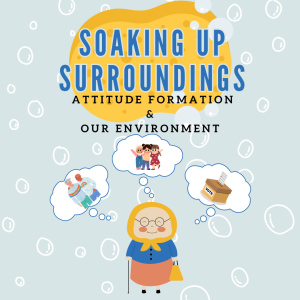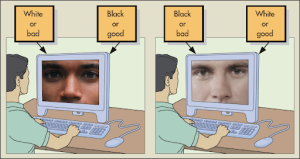Soaking Up Surroundings: Attitude Formation & Our Environment
By Vinchenzo Vassalotti, C2ST Intern, Loyola University
Much like a sponge, our experiences growing up, the people we meet, and the media we consume are all absorbed into our sense of self, values, and behavior. These values and how we express them, formally known as “attitudes”, are developed with and without intention. The intentional attitudes, those that we can outwardly express, are known as “explicit attitudes”. These attitudes are often expressed, via actions or verbal expressions, when one can give them thought and respond in a way that they perceive reflects their values or beliefs. “Implicit attitudes”, however, are buried deep within our unconscious. These attitudes are often expressed without thought and are spontaneous – formed in previous experiences and other uncontrollable influences.

Their differences can be tricky to understand. Let’s review a common example: political values. An explicit attitude may be expressed by simply telling others “I am a Democrat”, you may also demonstrate that by voting along party lines. However, an implicit attitude is presented a bit differently. Considering that we are unaware of these attitudes, they are often reflected in judgements and other quick-paced thinking. An example would be someone who has been regularly exposed to stereotypes that Democrats are bad at managing the economy. Outwardly, they may, explicitly, express that they don’t believe this stereotype to be true, “it is about the individual, not the whole party”. An implicit attitude, however, acknowledges that the repetitive pairing of this stereotype to the social group becomes embedded in our experiences. So, when hastily voting for a financial board position, they may quickly vote Republican, as in this short moment, lacking deliberation, a Republican abruptly comes to mind as better for the economy.
As you can see, although implicit attitudes are harder to identify, they are just as influential (Learn More Here!). Understanding how we form these attitudes can tell us a lot about our local environment and the way we might interact with our world. These value expressions influence how we view and interact with other social groups. This can have implications ranging from the friendships we seek to the public policy we vote for.
These attitudes are of key interest to scientists in the field of social psychology as they are influences on social interaction and the drivers behind our expressed statements and behaviors. In social psychology, the study of how people’s thoughts, feelings, and behaviors are influenced by the actual or imagined presence of others, we can measure these attitudes in different ways. An easily expressed explicit attitude can be captured by a simple questionnaire. For example, “On a 1-7 scale, with 1 being liberal and 7 being conservative, where do you place yourself?” However, those “hard to reach” implicit attitudes often involve more complex methods, such as an “Implicit Association Task” (Take Your Own IAT!).
Typically, IATs involve participants quickly grouping objects into categories. The amount of time one takes to group the object with a category tells us the strength of the attitude. These objects, often nouns, can be faces, like the example below, or first names, that correspond to a racial group. Objects can also be age groups, body types, policy initiatives, or even two dueling ice cream flavors! These categories are often two opposing adjectives that help identify the attitude’s direction like good to bad, or nice to mean. So, if someone groups a particular racial group’s face to “Bad”, at a faster rate than they group a different racial group’s face to “Good”, they are likely demonstrating an implicit bias toward the unfavorably grouped race. Here’s a visual example:

In this Implicit Association Task, the participant is grouping Black and White faces (objects) to “good” or “bad” (descriptive categories). The faster they group a particular race to a descriptor, the stronger their attitude toward the object on the descriptor! (Read more about IAT’s, and find the source of this image here!)
A researcher in the social psychology field, Dr. Nilanjana Dasgupta, has taken the study of these implicit attitudes a step forward – exploring local environments. This includes one’s viewed social and visual media, along with their local, social community like friends and family, or their childhood neighborhood. Her field of work explores both the measurement of these attitudes and their consequences. Reviewing the work on attitudes by Dr. Dasgupta, there is much to learn about how our environments and the media we consume influence our opinions and behavior. Let’s take a look!
Exploring the Local Environment
Dr. Dasgupta’s study began with measuring participants’ implicit racism bias based on the media they were immersed in. Participants were assigned to one of the following experimental groups…
- Test Group #1: “Pro-Black” media environment (presented famous and admired African Americans amongst disliked and infamous White Americans),
- Test Group #2: “Pro-White” media environment (presented famous and admired White Americans amongst disliked and infamous African Americans)
- Comparison Group: “Control” media environment (presented flowers and insects)
Then, participants took an IAT measuring attitudes towards popular Black and White first names as “pleasant” or “unpleasant”. Dr. Dasgupta and her team found that individuals immersed in the “Pro-Black” media environment presented significantly less implicit racism, than those in the “Pro-White” media environment or the “Comparison Group”. This study was then replicated, but with “Pro-Elderly” and “Pro-Youth” media environments, and the findings remained.
This study was then replicated for Pro-gay and Anti-gay attitudes but with an added focus toward legislative support. Using the same structure, they measured implicit bias attitudes toward LGBTQ+ people, and participant’s support of gay-friendly public policy. Those who had LGBTQ+ people in their local environment already presented positive attitudes toward gay people and gay-friendly policy. However, the notable takeaway was that the implicit attitudes of those who didn’t have any LGBTQ+ connections experienced the most significant effects of the gay-friendly media condition. Particularly, they were more likely to support gay-friendly policies, and also presented more supportive attitudes toward gay individuals.
Today’s Takeaway*
Dr. Dasgupta discusses that our environments are often uncontrollable – we end up in certain locations by happenstance. In some instances, individuals may have a family member who comes out, or a new elderly colleague. However, Dr. Dasgupta notes that this study emphasizes the importance of positive contact, even if minimal, with members of stereotyped groups. She characterizes it as an “invaluable” way to address and counter our implicit biases, especially for those without diverse, local environments.
When reflecting on this summary of only a small part of Dasgupta’s larger collection of work, we can see the influence our surroundings can have on our personal values and behaviors. While the findings of these studies lasted around 24 hours, imagine the outcome if you were exposed to a diverse, local environment daily! Being mindful of the social media we consume and the makeup of our surroundings plays an essential role in our ability to be allies, friends, and supportive neighbors.
*This blog has reviewed only 1 of 4 “lines of research” that Dr. Dasgupta has studied– take a look at the cited references to read more about attitudes and their implications!
References:
- Frequently Asked Questions Regarding Attitudes
- (PDF) Implicit Attitudes and Beliefs Adapt to Situations: A Decade of Research on the Malleability of Implicit Prejudice, Stereotypes, and the Self-Concept
- https://www.implicitdasgupta.org/
- Harvard Implicit Association Test
- Image Citation: https://practicalpie.com/implicit-association-test/